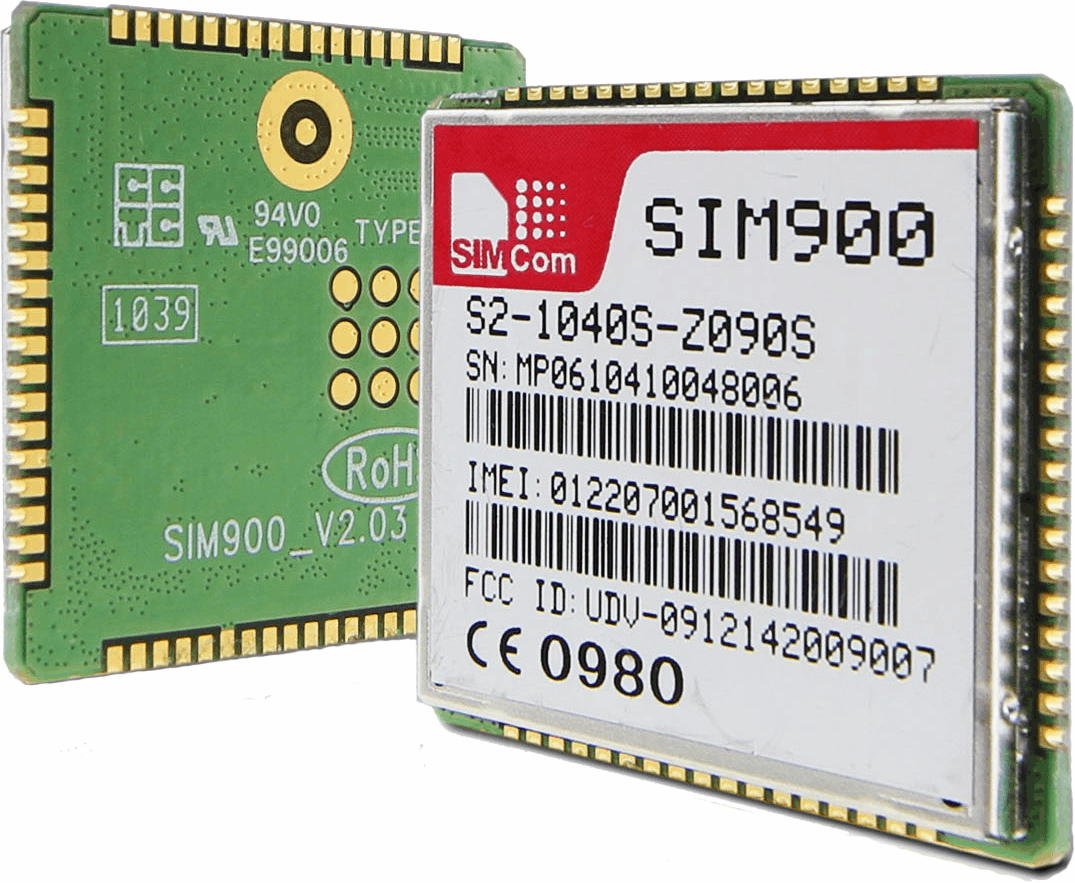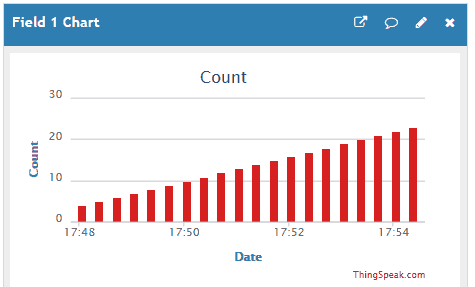Introduction
 Sim900A
Sim900A
SIM900 enables GPRS connectivity to embedded applications. We can implement HTTP Client protocol using SIM900 HTTP function AT Commands.
The Hypertext Transfer Protocol (HTTP) is a standard application layer protocol which functions as a request response protocol in between server and client.
It is widely used in IoT (Internet of Things) embedded applications, where every sensor is connected to a server and we have access to control them over the internet.
The GSM/GPRS module uses UART communication to communicate with microcontroller or PC terminal. AT commands are used to configure the module in different modes and to perform various functions like calling, posting data to a site, etc.
For more information about Sim900A and how to use it, refer the topic Sim900A GSM/GPRS Module in the sensors and modules section.
For information about UART in LPC2148 and how to use it, refer the topic UART in LPC2148 in the ARM7-LPC2148 inside section.
Interfacing Diagram
.png) Interfacing Sim900A GPRS Module with LPC2148
Interfacing Sim900A GPRS Module with LPC2148
Example
Sending data and reading data from a remote server using SIM900A as a HTTP Client.
Here, we will be using Thingspeak server for demo purpose.
Thingspeak is an open IOT platform where anyone can visualize and analyse live data from their sensor devices. We can also perform data analysis on data posted by remote devices with Matlab code in Thingspeak. To learn more about Thingspeak refer link https://thingspeak.com/pages/learn_more.
Just sign up and create a channel. We have created a channel with the ID and write key as given below on Thingspeak for sending and receiving data.
- channel ID is = 119922
- Write Key is = C7JFHZY54GLCJY38
Note: Do not forget to tick Make Public field in channel setting option on your Thingspeak channel. It makes the channel available to use as public.
For HTTP GET method, use AT commands as shown in the screenshot of RealTerm software given below.
The screenshot consists of AT commands (Green) and Responses (Yellow).
For HTTP POST method, use AT commands as shown in the screenshot of RealTerm software given below.
The screenshot consists of AT commands (Green) and Responses (Yellow).
In below program of HTTP Client, do the following
For HTTP Client GET Demo
#define GET_DEMO /* Define GET demo */
//#define POST_DEMO /* Define POST demo */
For HTTP Client POST Demo
//#define GET_DEMO /* Define GET demo */
#define POST_DEMO /* Define POST demo */
Program for HTTP Client
/*
HTTP Client using GPRS(SIM800/900) with LPC2148(ARM7)
http://www.electronicwings.com/arm7/sim900a-gprs-module-interfacing-with-lpc2148
*/
#include <lpc214x.h>
#include <stdint.h>
#include <stdio.h>
#include <stdlib.h>
#include <stdbool.h>
#include <string.h>
#define DEFAULT_BUFFER_SIZE 200 /* Define default buffer size */
#define DEFAULT_TIMEOUT 20000 /* Define default timeout */
#define DEFAULT_CRLF_COUNT 2 /* Define default CRLF count */
#define POST 1 /* Define method */
#define GET 0
/* Select Demo */
//#define GET_DEMO /* Define GET demo */
#define POST_DEMO /* Define POST demo */
/* Define Required fields shown below */
#define URL "api.thingspeak.com/update"
#define API_WRITE_KEY "C7JFHZY54GLCJY38"
#define CHANNEL_ID "119922"
#define APN "internet"
#define USERNAME ""
#define PASSWORD ""
enum SIM900_RESPONSE_STATUS /* Enumerate response status */
{
SIM900_RESPONSE_WAITING,
SIM900_RESPONSE_FINISHED,
SIM900_RESPONSE_TIMEOUT,
SIM900_RESPONSE_BUFFER_FULL,
SIM900_RESPONSE_STARTING,
SIM900_RESPONSE_ERROR
};
char Response_Status, CRLF_COUNT = 0;
uint16_t Counter = 0;
uint32_t TimeOut = 0;
char RESPONSE_BUFFER[DEFAULT_BUFFER_SIZE];
__irq void UART0_Interrupt(void);
void delay_ms(uint16_t j)
{
uint16_t x,i;
for(i=0;i<j;i++)
{
for(x=0; x<6000; x++); /* loop to generate 1 milisecond delay with Cclk = 60MHz */
}
}
void UART0_init(void)
{
PINSEL0 = PINSEL0 | 0x00000005; /* Enable UART0 Rx0 and Tx0 pins of UART0 */
U0LCR = 0x83; /* DLAB = 1, 1 stop bit, 8-bit character length */
U0DLM = 0x00; /* For baud rate of 9600 with Pclk = 15MHz */
U0DLL = 0x61; /* We get these values of U0DLL and U0DLM from formula */
U0LCR = 0x03; /* DLAB = 0 */
U0IER = 0x00000001; /* Enable RDA interrupts */
}
void UART0_TxChar(char ch) /* A function to send a byte on UART0 */
{
U0IER = 0x00000000; /* Disable RDA interrupts */
U0THR = ch;
while( (U0LSR & 0x40) == 0 ); /* Wait till THRE bit becomes 1 which tells that transmission is completed */
U0IER = 0x00000001; /* Enable RDA interrupts */
}
void UART0_SendString(char* str) /* A function to send string on UART0 */
{
U0IER = 0x00000000; /* Disable RDA interrupts */
uint8_t i = 0;
while( str[i] != '\0' )
{
UART0_TxChar(str[i]);
i++;
}
U0IER = 0x00000001; /* Enable RDA interrupts */
}
void Read_Response() /* Read response */
{
static char CRLF_BUF[2];
static char CRLF_FOUND;
uint32_t TimeCount = 0, ResponseBufferLength;
while(1)
{
if(TimeCount >= (DEFAULT_TIMEOUT+TimeOut)) /* Check timecount each time */
{
CRLF_COUNT = 0; TimeOut = 0;
Response_Status = SIM900_RESPONSE_TIMEOUT;/* if its overflowed then make status timeout and return */
return;
}
if(Response_Status == SIM900_RESPONSE_STARTING)
{
CRLF_FOUND = 0;
memset(CRLF_BUF, 0, 2);
Response_Status = SIM900_RESPONSE_WAITING;/* Make status waiting while reading */
}
ResponseBufferLength = strlen(RESPONSE_BUFFER);
if (ResponseBufferLength)
{
delay_ms(1);
TimeCount++;
if (ResponseBufferLength==strlen(RESPONSE_BUFFER))
{
for (uint16_t i=0;i<ResponseBufferLength;i++)
{
memmove(CRLF_BUF, CRLF_BUF + 1, 1);
CRLF_BUF[1] = RESPONSE_BUFFER[i];
if(!strncmp(CRLF_BUF, "\r\n", 2))
{
if(++CRLF_FOUND == (DEFAULT_CRLF_COUNT+CRLF_COUNT))
{
CRLF_COUNT = 0; TimeOut = 0;
Response_Status = SIM900_RESPONSE_FINISHED;
return;
}
}
}
CRLF_FOUND = 0;
}
}
delay_ms(1);
TimeCount++;
}
}
void Start_Read_Response()
{
Response_Status = SIM900_RESPONSE_STARTING;
do {
Read_Response();
} while(Response_Status == SIM900_RESPONSE_WAITING);/* Read response till response is waiting */
}
void Buffer_Flush() /* Flush all variables */
{
memset(RESPONSE_BUFFER, 0, DEFAULT_BUFFER_SIZE);
Counter=0;
}
/* Remove CRLF and other default strings from response */
void GetResponseBody(char* Response, uint16_t ResponseLength)
{
uint16_t i = 12;
char buffer[5];
while(Response[i] != '\r' && i < 100)
++i;
strncpy(buffer, Response + 12, (i - 12));
ResponseLength = atoi(buffer);
i += 2;
uint16_t tmp = strlen(Response) - i;
memcpy(Response, Response + i, tmp);
if(!strncmp(Response + tmp - 6, "\r\nOK\r\n", 6))
memset(Response + tmp - 6, 0, i + 6);
}
bool WaitForExpectedResponse(char* ExpectedResponse)
{
Buffer_Flush();
delay_ms(200);
Start_Read_Response(); /* First read response */
if((Response_Status != SIM900_RESPONSE_TIMEOUT) && (strstr(RESPONSE_BUFFER, ExpectedResponse) != NULL))
return true; /* Return true for success */
return false; /* Else return false */
}
bool SendATandExpectResponse(char* ATCommand, char* ExpectedResponse)
{
UART0_SendString(ATCommand); /* Send AT command to SIM900 */
UART0_TxChar('\r');
return WaitForExpectedResponse(ExpectedResponse);
}
bool HTTP_Parameter(char* Parameter, char* Value)/* Set HTTP parameter and return response */
{
UART0_SendString("AT+HTTPPARA=\"");
UART0_SendString(Parameter);
UART0_SendString("\",\"");
UART0_SendString(Value);
UART0_SendString("\"\r");
return WaitForExpectedResponse("OK");
}
bool SIM900HTTP_Start() /* Check SIM900 board */
{
for (uint8_t i=0;i<5;i++)
{
if(SendATandExpectResponse("ATE0","OK")||SendATandExpectResponse("AT","OK"))
{
HTTP_Parameter("CID","1"); /* set Bearer profile identifier */
return true;
}
}
return false;
}
bool SIM900HTTP_Connect(char* _APN, char* _USERNAME, char* _PASSWORD) /* Connect to GPRS */
{
UART0_SendString("AT+CREG?\r");
if(!WaitForExpectedResponse("+CREG: 0,1"))
return false;
UART0_SendString("AT+SAPBR=0,1\r");
WaitForExpectedResponse("OK");
UART0_SendString("AT+SAPBR=3,1,\"CONTYPE\",\"GPRS\"\r");
WaitForExpectedResponse("OK");
UART0_SendString("AT+SAPBR=3,1,\"APN\",\"");
UART0_SendString(_APN);
UART0_SendString("\"\r");
WaitForExpectedResponse("OK");
UART0_SendString("AT+SAPBR=3,1,\"USER\",\"");
UART0_SendString(_USERNAME);
UART0_SendString("\"\r");
WaitForExpectedResponse("OK");
UART0_SendString("AT+SAPBR=3,1,\"PWD\",\"");
UART0_SendString(_PASSWORD);
UART0_SendString("\"\r");
WaitForExpectedResponse("OK");
UART0_SendString("AT+SAPBR=1,1\r");
return WaitForExpectedResponse("OK");
}
bool HTTP_Init() /* Initiate HTTP */
{
UART0_SendString("AT+HTTPINIT\r");
return WaitForExpectedResponse("OK");
}
bool HTTP_Terminate() /* terminate HTTP */
{
UART0_SendString("AT+HTTPTERM\r");
return WaitForExpectedResponse("OK");
}
bool HTTP_SetURL(char * url) /* Set URL */
{
return HTTP_Parameter("URL", url);
}
bool HTTP_Connected() /* Check for connected */
{
UART0_SendString("AT+SAPBR=2,1\r");
CRLF_COUNT = 2; /* Make additional crlf count for response */
return WaitForExpectedResponse("+SAPBR: 1,1");
}
bool HTTP_SetPost_json() /* Set Json Application format for post */
{
return HTTP_Parameter("CONTENT", "application/json");
}
bool HTTP_Save() /* Save the application context */
{
UART0_SendString("AT+HTTPSCONT\r");
return WaitForExpectedResponse("OK");
}
bool HTTP_Data(char* data) /* Load HTTP data */
{
char _buffer[25];
sprintf(_buffer, "AT+HTTPDATA=%d,%d\r", strlen(data), 10000);
UART0_SendString(_buffer);
if(WaitForExpectedResponse("DOWNLOAD"))
return SendATandExpectResponse(data, "OK");
else
return false;
}
bool HTTP_Action(char method) /* Select HTTP Action */
{
if(method == GET)
UART0_SendString("AT+HTTPACTION=0\r");
if(method == POST)
UART0_SendString("AT+HTTPACTION=1\r");
return WaitForExpectedResponse("OK");
}
bool HTTP_Read(uint8_t StartByte, uint16_t ByteSize) /* Read HTTP response */
{
char Command[25];
sprintf(Command,"AT+HTTPREAD=%d,%d\r",StartByte,ByteSize);
Command[24] = 0;
UART0_SendString(Command);
CRLF_COUNT = 2; /* Make additional crlf count for response */
if(WaitForExpectedResponse("+HTTPREAD"))
{
GetResponseBody(RESPONSE_BUFFER, ByteSize);
return true;
}
else
return false;
}
uint8_t HTTP_Post(char* Parameters, uint16_t ResponseLength)
{
HTTP_Parameter("CID","1"); /* set Bearer profile identifier */
if(!(HTTP_Data(Parameters) && HTTP_Action(POST)))
return SIM900_RESPONSE_TIMEOUT;
bool status200 = WaitForExpectedResponse(",200,");
if(Response_Status == SIM900_RESPONSE_TIMEOUT)
return SIM900_RESPONSE_TIMEOUT;
if(!status200)
return SIM900_RESPONSE_ERROR;
HTTP_Read(0, ResponseLength);
return SIM900_RESPONSE_FINISHED;
}
uint8_t HTTP_get(char * _URL, uint16_t ResponseLength)
{
HTTP_Parameter("CID","1"); /* set Bearer profile identifier */
HTTP_Parameter("URL", _URL);
HTTP_Action(GET);
WaitForExpectedResponse("+HTTPACTION:0,");
if(Response_Status == SIM900_RESPONSE_TIMEOUT)
return SIM900_RESPONSE_TIMEOUT;
HTTP_Read(0, ResponseLength);
return SIM900_RESPONSE_FINISHED;
}
bool SIM900HTTP_Init()
{
HTTP_Terminate();
return HTTP_Init();
}
__irq void UART0_Interrupt(void)
{
RESPONSE_BUFFER[Counter] = U0RBR; /* Copy data to buffer & increment counter */
Counter++;
if(Counter == DEFAULT_BUFFER_SIZE)
Counter = 0;
VICVectAddr = 0x00;
}
int main(void)
{
char _buffer[100];
#ifdef POST_DEMO
uint8_t Sample = 0;
#endif
VICVectAddr0 = (unsigned) UART0_Interrupt; /* UART0 ISR Address */
VICVectCntl0 = 0x00000026; /* Enable UART0 IRQ slot */
VICIntEnable = 0x00000040; /* Enable UART0 interrupt */
VICIntSelect = 0x00000000; /* UART0 configured as IRQ */
UART0_init();
while(!SIM900HTTP_Start());
while(!(SIM900HTTP_Connect(APN, USERNAME, PASSWORD)));
SIM900HTTP_Init();
#ifdef POST_DEMO
HTTP_SetURL(URL);
HTTP_Save();
#endif
while(1)
{
if (!HTTP_Connected()) /* Check whether GPRS connected */
{
SIM900HTTP_Connect(APN, USERNAME, PASSWORD);
SIM900HTTP_Init();
}
/* Take local buffer to copy response from server */
uint16_t responseLength = 100;
#ifdef POST_DEMO /* POST Sample data on server */
memset(_buffer, 0, 100);
sprintf(_buffer, "api_key=%s&field1=%d", API_WRITE_KEY, Sample++);
HTTP_Post(_buffer, responseLength);
delay_ms(15000); /* Thingspeak server delay */
#endif
#ifdef GET_DEMO /* GET last sample data from server */
memset(_buffer, 0, 100);
sprintf(_buffer, "api.thingspeak.com/channels/%s/feeds/last.txt", CHANNEL_ID);
HTTP_get(_buffer, responseLength);
#endif
}
}
SIM900 Response
At the client end, we need to check SIM900 responses. We can check it on the serial terminal of PC/Laptop. Connect SIM900 transmit pin (TX) to the receive pin (RX) of LPC2148 and to the receive pin (RX) of usb to serial converter as shown in below figure. Connect usb to serial converter to PC/Laptop. Open the serial terminal on PC/Laptop to see the SIM900 responses for the AT command sent from PIC microcontroller.

LPC2148 Interface with SIM900 GSM along with PC
Now for HTTP POST commands (sent from LPC2148), we can see the below response from SIM900 on the serial terminal for the Thingspeak server.
In response with HTTP POST we get the data entry no. as shown in above figure i.e. 974, 975, and so on.
For HTTP GET commands (sent from LPC2148), we can see the below response from SIM900 on the serial terminal for the Thingspeak server.
In response with HTTP GET, we get the last entry data for field1 on thingspeak as shown in above figure.
Note: here we are retrieving the last entry data on field1 of thingspeak server hence we get the last updated data of field1 from server as shown in above figure i.e. “field1”:”2”. In program, we used "api.thingspeak.com/channels/119922/feeds/last.txt" to receive last updated data only.
Updates at Thingspeak server on HTTP POST
For HTTP POST we can see the output at the server end. Here we are using Thingspeak server and sending the incremented count at field1 on a server. We get incremented count at field1 of Thingspeak server as shown in below figure.

Data on Thingspeak Server
Components Used |
||
|---|---|---|
| ARM7 LPC2148 ARM7 LPC2148 |
X 1 | |
| SIM900A GSM GPRS Module SIM900A is dual band GSM/GPRS 900/1800MHz module board used to utilize GSM and GPRS services around the globe. It is used to make/receive voice calls, send/receive text messages, connect to and access the internet over GPRS. |
X 1 | |
Downloads |
||
|---|---|---|
|
|
HTTP_Client_uVision_Project | Download |
